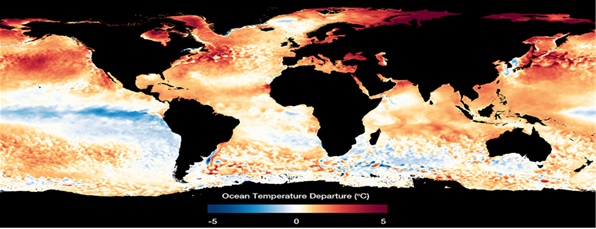Why in the NEWS?
- A marine heat wave in Western Australia in January 2025 causes the deaths of more than 30,000 fish.

Key Points:
- Marine Heatwaves (MHW) are intensifying due to climate change, with sea surface temperatures rising significantly in various regions, such as Western Australia.
- MHW leads to devastating impacts on marine life, including large-scale fish deaths, coral bleaching, and the destruction of kelp forests.
- The frequency and severity of MHWs have increased over the past few decades, with global warming exacerbating these trends.
What will you read next in this topic?
- What are marine heatwaves (MHW)?
- Event in Western Australia (January 2025):
- Increasing intensity of marine heatwaves:
- Effects on marine life:
- Impacts on the Great Barrier Reef:
- Global consequences of marine heatwaves:
- Implications for marine ecosystems:
- Projections for the future:
What are marine heatwaves (MHW)?
- Definition: A marine heatwave (MHW) is a climate phenomenon in which the sea surface temperature (SST) in a specific region is 3-4°C above the average temperature for at least five consecutive days.
- Duration: MHWs can last for weeks, months or even years. As defined by NOAA (National Oceanic and Atmospheric Administration), these heatwaves can vary in duration depending on environmental conditions.
- Significance: SST during a heatwave can rise to levels that severely impact marine ecosystems, causing disruptions to marine biodiversity, fisheries and coastal habitats.
Event in Western Australia (January 2025):
- Event overview: In January 2025, more than 30,000 fish died due to an ongoing MHW in the coastal waters of Western Australia.
- Climate change impacts: According to an analysis by Climate Central, this event is 100 times more likely to be induced by climate change.
- The MHW began in September 2024 and continues, further increasing the region’s vulnerability to extreme climate events.
- Regional consequences: This MHW is now considered the second most severe in Western Australia’s recorded history, underlining the increasing intensity of such events.
Increasing intensity of marine heatwaves:
- Long-term trend: Over the past few decades, SSTs have increased by about 0.9°C globally.
- A significant portion of this increase is due to climate change, with oceans absorbing about 90% of the additional heat caused by global warming.
- Increased frequency and severity: From 1982 to 2016, the number of days affected by MHWs doubled, according to a study published in the journal Nature in 2018.
- The International Union for Conservation of Nature (IUCN) reported a 50% increase in MHWs over the last decade, noting that these events now last longer and are more severe.
- Forecasts for the future: MHWs are projected to become more intense as global temperatures increase.
- One study indicated that with 1.5 degrees Celsius of global warming, the number of MHWs will increase 16-times, and with 2 degrees Celsius, they will increase 23-times.
Effects on marine life:
- Massive fish kills: MHWs caused by these events cause sudden deaths of marine species in some areas, dramatically impacting local marine populations.
- Destruction of kelp forests: Kelp forests, which thrive in cold waters, provide critical habitats and food sources for many marine species.
- MHWs pose a major threat to these ecosystems, causing their degradation, which in turn affects the wider marine food web.
- Coral Bleaching: One of the most severe consequences of MHW is coral bleaching.
- Increased water temperatures cause corals to expel the symbiotic algae that live within them, causing corals to turn white and become more susceptible to disease.
- This is detrimental to coral reef ecosystems, which support a large number of marine species.
Impacts on the Great Barrier Reef:
- Recent events: In 2024, the Great Barrier Reef experienced a catastrophic level of coral bleaching, triggered by an intense MHW.
- This was the seventh mass bleaching event recorded on the reef.
- Such frequent events of coral bleaching reflect the continued vulnerability of these delicate ecosystems to rising sea temperatures.
- Long-term consequences: The recurring nature of coral bleaching events threatens the long-term viability of the reef.
- If these MHWs continue, it could lead to a permanent loss of biodiversity in these ecosystems, causing further disruption to marine life and the local economies that depend on them.
Global consequences of marine heatwaves:
- Deteriorating global situation: As the planet warms, the intensity, frequency, and duration of MHWs are expected to worsen globally.
- According to a study in the journal Nature, the number of MHW days is steadily increasing globally.
- With 1.5°C global warming, MHWs could become a ubiquitous phenomenon that could affect a wide range of marine ecosystems.
- Regional variability: While significant impacts are already being observed in areas such as Western Australia, the threat is global.
- Sea heat waves have been observed in both surface and deep ocean layers, at different latitudes, and in all types of marine ecosystems, making them a widespread and growing concern for marine biodiversity.
Implications for marine ecosystems:
- Biodiversity disruption: The combination of fish kills, kelp forest degradation and coral bleaching results in severe disruption of marine biodiversity.
- Marine heatwaves affect the reproductive cycles of marine species, reducing biodiversity and can lead to long-term ecological shifts.
- Economic impacts: Marine industries such as fisheries, tourism and coastal management are also significantly affected by the consequences of MHWs.
- As marine life populations decline and ecosystems deteriorate, the livelihoods of people dependent on these industries are at risk.
Projections for the future:
- Increased vulnerability: As global temperatures rise, marine ecosystems will become more vulnerable to heat stress.
- With higher global SSTs, the likelihood of more frequent and severe MHWs is expected to increase, putting further pressure on marine biodiversity and ecosystems.
- Possibility of ocean changes: Continued warming of the oceans can lead to major changes in ocean currents, making marine life cycles and habitats even more unstable.
- Its effects can be felt throughout the global food chain, from the smallest plankton to the largest marine mammals.
|
Q. Which region experienced a "devastating" level of coral bleaching in 2024 due to Marine Heatwaves?
(a) Mediterranean Sea
(b) Caribbean Sea
(c) Great Barrier Reef
(d) South Pacific Ocean
|



